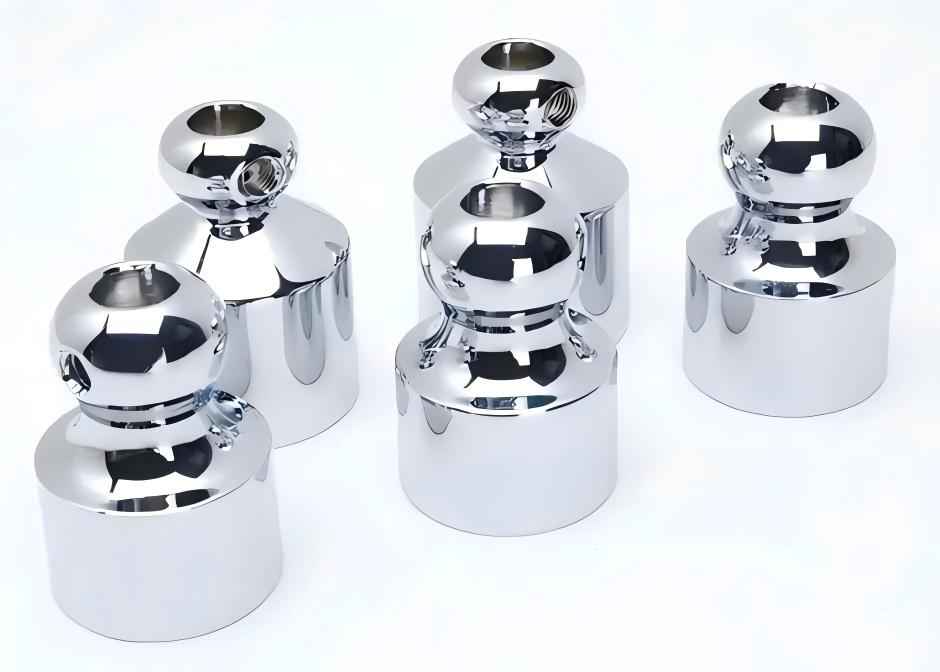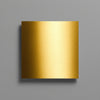What is chromate conversion, this blog is enough.

What is Chromate Conversion
Chromate conversion is a kind of chemical conversion coating. When we immerse metal parts into the acidic chemical solution(contains chromate). An oxidation - reduction is happening, then the metal surface will form a thin coating to protect the substrate.
The chromate conversion coating need 3 step to be formed:
- the metal surface atomic is oxidized and transferred to the solution to produce atomic hydrogen.
- The atomic hydrogen make the reduction of hexavalent chromium to trivalent chromium. This action causes solution PH to increase, Interface, the trivalent chromium is precipitated in form of chromium hydroxide.
- Then the chromium hydroxide colloid adsorbs and combines a part of hexavalent chromium from the solution to form a chromate conversion coating with a composition at the metal interface. When this conversion coating is slightly damaged, the soluble hexavalent chromium compound can re-passivate the area and play a role in preventing corrosion.
Properties of Chromate Conversion in Surface Treatment
Chromate conversion coating is a chemically stable acidic substance. In surface treatment, it can passivate the metal surface, increase the surface hardness, improve the adhesion of the coating, and improving the corrosion resistance of the substance. In addition, it can also decorate part surface.
Rust Rrevention Treatment
Chromate conversion process improves the corrosion resistance of metals by forming a protective coating. It is mainly composed of chromates, which can effectively prevent the metal surface contacting with corrosive substances in the environment.
Specific functions:
- Self-healing properties: Soluble chromates from the surrounding area seep out and precipitate on the metal surface. if it is scratched or worn, the coating allow to self-heal.
-
Chemical stability: The chromate coating has good chemical stability and can effectively resist erosion by water and oxygen.
- Environmental corrosion resistance: It provides excellent protection in marine atmospheres and high humidity environments.
Cleaning Process
Chromate conversion liquid can effectively remove dirt and oil from the metal surface, making the metal surface cleaner.
Improve Surface Hardness
After the metal surface is chromated, a dense passivation layer will be formed, which will enhance the hardness and wear resistance of the metal material, while improving the color and appearance on the metal surface.
Improve Coating Adhesion
Specific functions:
- Chemical Sticking: Coating and paint enhance the overall sticking effect.
- Enhanced Sticking Strength: The surface properties of the coating increase the sticking strength of the paint to the metal surface.
- Improved Surface Roughness: Due to the increased surface roughness, it provides more contact points, thereby enhancing adhesion.
While chromate conversion surface treatment is primarily used for corrosion protection and adhesion enhancement, it also maintains the conductivity of the metal to a certain extent. This is essential for electrical connection applications such as the aerospace and electronics industries.
Specific Functions:
Electrical connection: It allows parts that require electrical connection, such as aircraft landing gear and control systems, to maintain good conductivity.
Low resistance: The coating itself has a certain conductivity and low resistance.
Shading
Chromate conversion can be used as a coloring treatment for metal materials to improve the gloss and color of its surface and make it more decorative. The outer layer of the treated metal is brightly colored, ranging from colorless, transparent or milky white to yellow, golden yellow, light green, green, olive, dark green and brown, and even black.
Application of chromate conversion in the manufacture of machined products
Electronic industry
- Electronic components often require high-purity chemicals, and chromate conversion parts act as high-purity materials in circuit board manufacturing and the semiconductor industry.
- Used in electronic equipment housings to provide higher corrosion resistance while maintaining conductivity.
Automotive industry
- Used for corrosion protection and paint adhesion of automotive parts such as radiators and rims.
- Enhance corrosion resistance and durability of parts while maintaining conductivity.
Aerospace Industry
- Used in aircraft fuselages, landing gear, and flight control system components.
- Improve corrosion resistance, improve paint adhesion, and maintain conductivity.
Material Synthesis
Parts in machined products often require specific materials. Chromate conversion can be used to synthesize materials with special properties to meet the needs of different industrial sectors.
Environment friendly coatings
In the face of increasingly stringent environmental regulations, environment friendly coatings prepared by chromate conversion are favored. These coatings do not contain harmful substances and it will help reduce environmental pollution.
Fasteners
Used for screws, hardware, and tools, often giving metals a unique rainbow color.
Metal Surface Treatment
Surface treatment of metal parts is crucial in the manufacture of machined products. Chromate conversion can be used for oxidation, corrosion protection, and modification of metal surfaces to improve the durability and performance of parts.
At present, our company generally applies this technology to environment friendly coatings and metal surface treatment.
Advantages of Chromate Conversion
Chromate conversion surface treatment is not suitable for all metal materials. In most cases, it is only used for metal materials such as aluminum, zinc, copper, steel, iron, tin, and cadmium. Specific application scenarios include:
Environmentally friendly
Compared with the traditional gas phase method for preparing chromate conversion, chromate conversion uses more environmentally friendly raw materials and methods, reduces the emission of harmful gases, and is conducive to protecting the environment.
Resource sustainability
Traditional methods rely on limited resources such as chlorine, while chromate conversion uses more sustainable raw materials such as aluminum powder and ammonium chloride, which contributes to the sustainable use of resources.
Precautions for chromate conversion surface treatment
Chromate conversion is highly corrosive, so during operation, relevant safety operating procedures must be strictly followed, and good ventilation and protective measures must be maintained.
The treated metal surface needs to be maintained during use to avoid mechanical scratches and chemical corrosion.
Chromate conversion surface treatment is very suitable for large-area, irregularly shaped metal objects. For the treatment of small parts, there are other more suitable surface treatment methods.
Metal surface treatment of different substrates requires different proportions of chromate conversion liquid, and the color and composition obtained after treatment will also be different.
Environmental and health issues
Although chromate conversion surface treatment is effective in industrial applications, it is facing more and more regulatory restrictions due to environmental and health issues caused by hexavalent chromium. Hexavalent chromium compounds are considered highly toxic due to their carcinogenic effects and environmental hazards after disposal.
Development of alternatives:
Trivalent chromium: As a possible alternative, it has better corrosion resistance than hexavalent chromium, although the effect is not as good.
Chromium-free treatment: Develop chromium-free surface treatment technology to reduce the impact on the environment and health.
The use of chlorine and hydrogen in traditional preparation methods is not only dangerous but also has a negative impact on the environment.
Chromate conversion is a more environmentally friendly and efficient alternative due to safer raw materials.
XTJ's metal parts chromate conversion surface treatment service
Chromate conversion surface treatment helps to improve the corrosion resistance and adhesion of metal surfaces. Due to its relatively low cost, it is widely used in various industries.
Our company is able to provide chromate conversion surface treatment for various metal parts. From part manufacturing to part surface finish, we can provide you with efficient and high-quality services. If you have an idea for part manufacturing or part surface treatment, then we will be your best choice.
To learn more about our services or get a quote, please do not hesitate to contact us.
FAQ
How thick is the chromate conversion film?
Typical range: Typically 0.01–3 µm (10–3000 nm), depending on substrate, process, and application.
Aluminum/alloys: ~0.1–1 µm.
Zinc/cadmium plating: ~0.25–3 µm (e.g., per MIL-DTL-5541).
Key Features: Very thin, yet provides significant corrosion resistance without sacrificing dimensional accuracy.
What is the purpose of chromate conversion?
The purpose is as follows:
Corrosion resistance: Forms a passive oxide layer that inhibits metal oxidation.
Paint adhesion: Improves adhesion of subsequent coatings (e.g., paint, powder coating).
Conductivity: Certain coatings (e.g., clear/iridescent) retain the electrical conductivity of electrons.
Cosmetic: Produces color (gold, iridescent, olive drab) based on thickness/process.
Abrasion resistance: Seal coating can enhance surface durability.
What are the criteria for chromate conversion coatings?
Chromate conversion coatings are produced to the following standards:
International/General Standards
- ISO 4520: Chromate coatings on zinc and cadmium.
- ASTM B201: Aluminum CCC test methods.
-
MIL-DTL-5541 (U.S. Military):
- Type I: Hexavalent chromium (Cr⁶⁺, conventional).
- Type II: Non-hexavalent (Cr³⁺, RoHS compliant).
Industry-specific standards
- Aerospace: AMS 2473 (aluminum), AMS 2474 (magnesium).
- Automotive: OEM specific (e.g., Ford WSS-M21P-A).
- Environmental regulations:
- RoHS/REACH: Restrictions on Cr⁶⁺, promotion of Cr³⁺ alternatives.
- DoD policy: U.S. Department of Defense exemptions for Cr⁶⁺ in critical applications.
-
Posted in
cnc machining, Post processing, surface process, Surface Roughness





